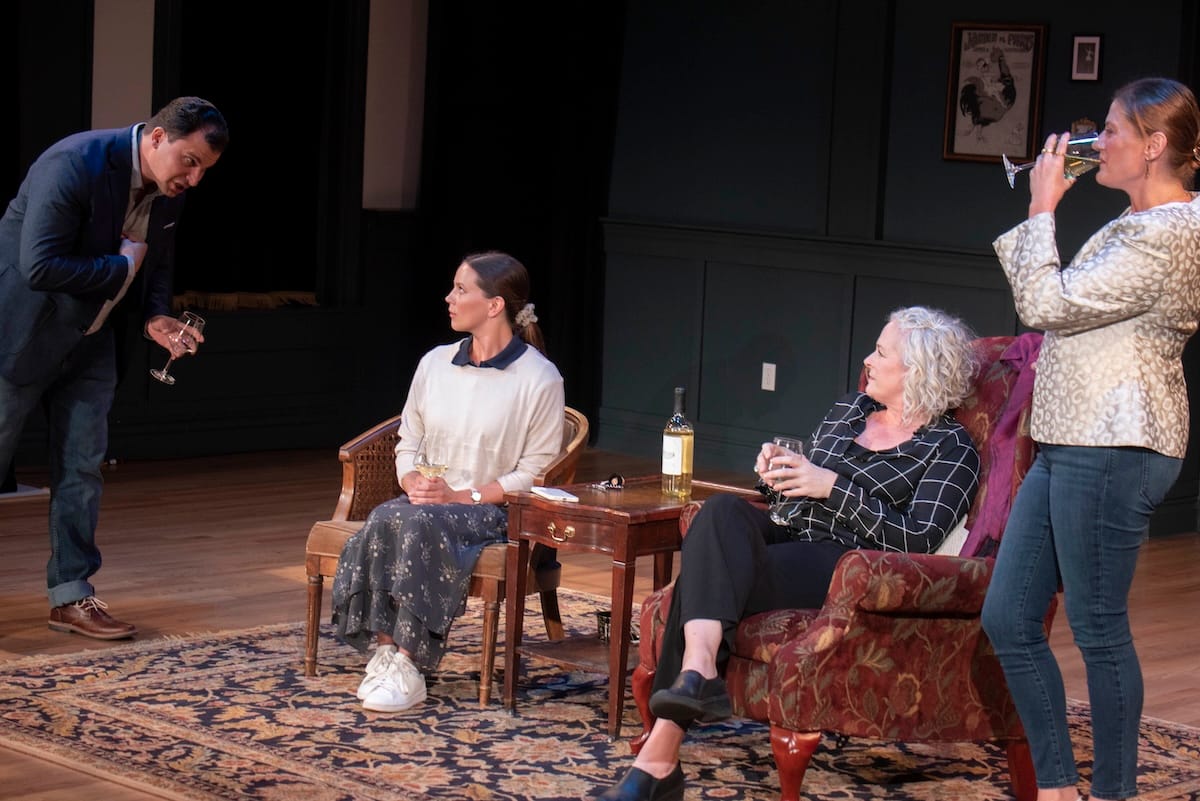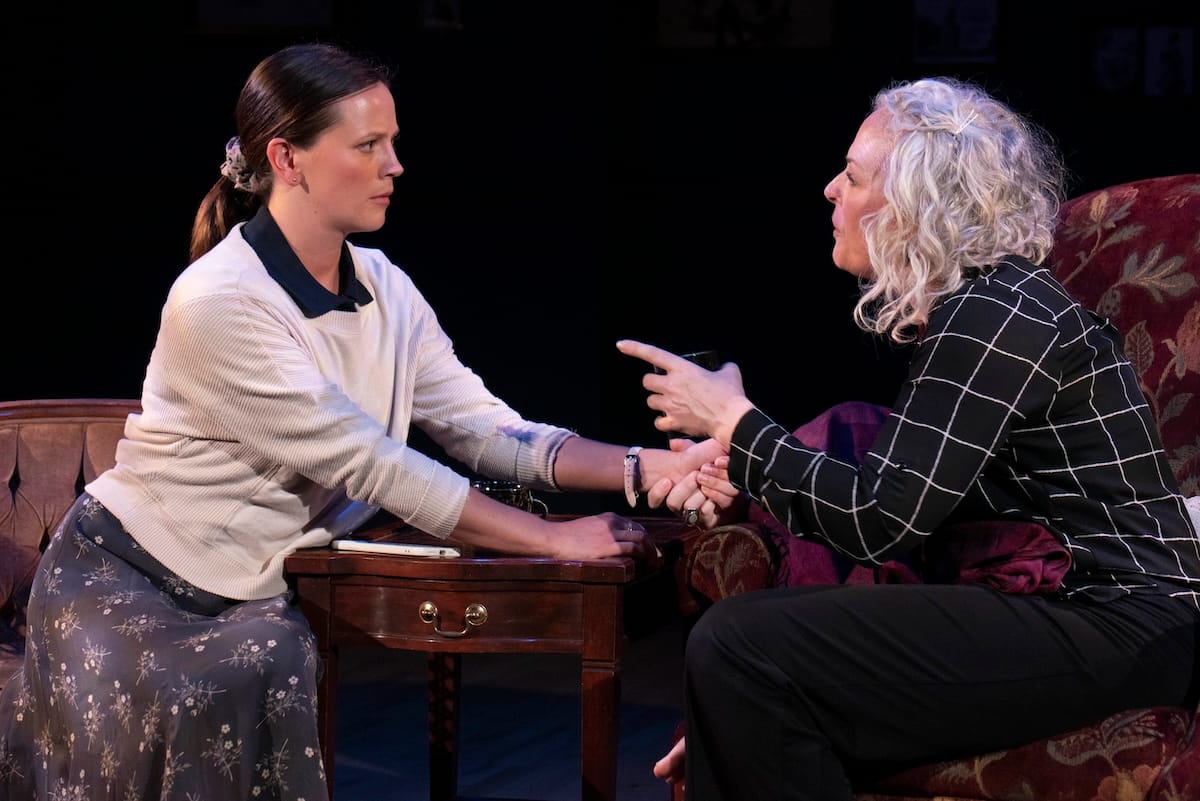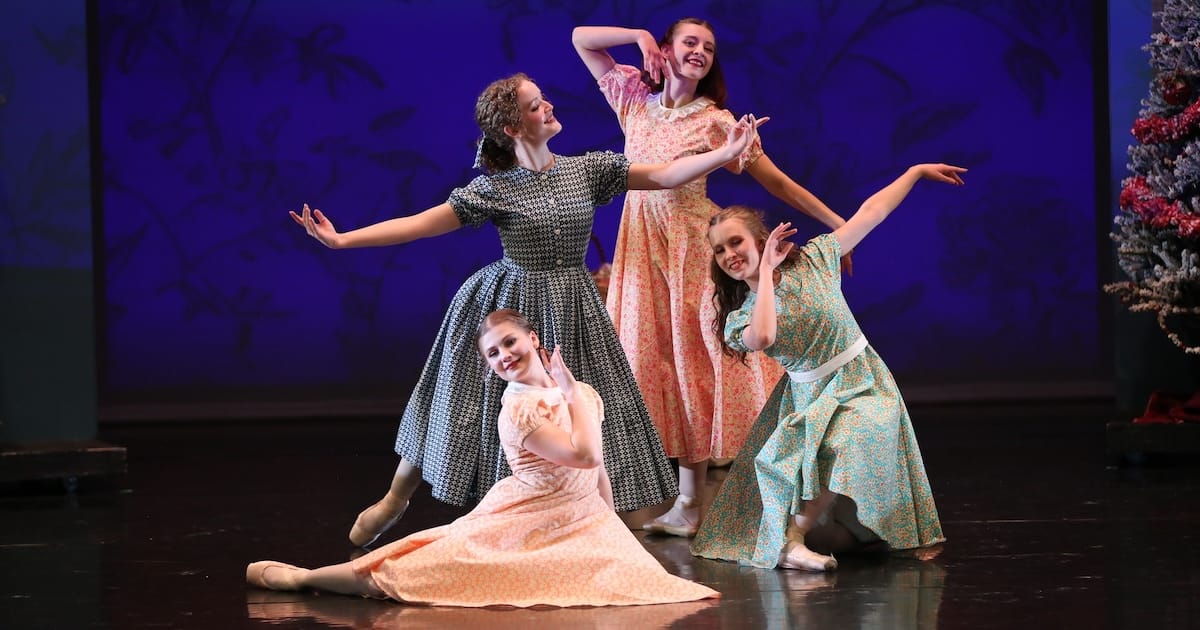Lucas Hnath’s eerie drama is given an intimate, spooky staging, with Madison Taylor leading a superb cast in one of the season’s most haunting productions.
If you’re easily shaken, The Thin Place might not be for you. For those who relish the idea of an expertly staged, psychologically charged ghost story, Boulder Ensemble Theatre Company’s regional premiere of Lucas Hnath’s drama is the perfect pick for spooky season and one of the year’s most riveting productions.
Under the precise direction of Jessica Robblee, the play forgoes spectacle in favor of suggestion, drawing its horror from silence, intimacy and uncertainty — with a good old-fashioned jump scare thrown in for fun.
The ghosts we carry
Before diving into how BETC pulls this off, it’s worth sketching the story Hnath has written.
The play centers on Hilda (Madison Taylor), a young woman marked by loss who becomes fascinated with Linda (Tara Falk), an English medium who insists that the dead linger just out of reach in “the thin place.” For Hilda, whose grandmother once encouraged her budding psychic abilities and whose mother has since mysteriously vanished, the lure of contact with the other side is almost too powerful to resist.
What begins as a tentative connection between seeker and guide soon expands into a charged evening with Linda’s wealthy patron Sylvia (Maggie Tisdale) and political consultant Jerry (Jihad Milhem). Their dinner party spirals into a fierce debate over truth, manipulation and belief before veering into the uncanny.
As reality frays, Hilda edges closer to crossing into the thin place herself, leaving both characters and audience unsure whether they’re witnessing supernatural intrusion or a breakdown of the mind.

Jihad Milhem, Madison Taylor, Tara Falk and Maggie Tisdale in ‘The Thin Place.’ | Photo: Michael Ensminger
Entering the séance
BETC is currently staging the play at The Savoy Denver on its unadorned second-floor stage. Folding chairs on a riser face two chairs onstage and a wall in the back with some photos on it.
Aside from a few well-chosen props, like a bottle of wine and glasses, the world is stripped of clutter, forcing attention onto what cannot be seen. It’s an ideal match for Hnath’s script, which thrives on suggestion.
Robblee wisely chose to begin the production without fanfare. On opening night at The Savoy Denver, the company skipped Managing Director Mark Ragan’s traditional opening speech and did not turn off the house lights.
Instead, Madison Taylor’s Hilda slipped onstage, sat in a plain chair and fixed her eyes on us. The lights remained fully on as she began to speak, scanning the audience and even pointing to one person, saying, “You look a lot like my grandmother,” before recounting her childhood.
That intimacy immediately dissolved the protective layer between actor and audience. We weren’t just watching a play; we had been invited into a séance.
Taylor’s first monologue, recalling the word-guessing games she played with her grandmother to test psychic powers, sets the tone for the whole production. It’s deceptively simple storytelling: just one woman in a chair. Yet the directness of her gaze and the tremor in her restraint suggest a character barely holding her grief together.

L-R: Jihad Milhem, Madison Taylor, Tara Falk and Maggie Tisdale in ‘The Thin Place.’ | Photo: Michael Ensminger
Profound performances
Taylor’s performance is a marvel of restraint and release. Early on, her Hilda is soft-spoken, even hesitant, but there’s always the sense of something bubbling beneath the surface. By the midpoint, as she spars with Linda about the authenticity of séances and recounts increasingly disturbing memories, Taylor allows that repression to slip, revealing flashes of her despair.
Her final monologue about humanity’s desire for certainty in an uncertain world hits like a gut punch. Taylor carries the production, but she also knows when to let silence, or the other actors, fill the space.
Tara Falk, as Linda, gives the play its sharp edges and occasional comic relief. With a crisp Cockney accent coached by Jeffrey Parker, she blends charm and toughness. Falk keeps Linda’s motives slippery: One moment she seems genuinely attuned to otherworldly voices, the next she dismisses her work as little more than a trick.
This ambiguity is crucial; without it, the play would collapse into either a ghost story or a psychological drama. Falk lets Linda live in the gap, and it keeps the tension alive.
Ideas and egos
Following the introduction of Hilda and Linda’s relationship, the narrative shifts to a dinner party. This setting introduces Maggie Tisdale’s Sylvia and Jihad Milhem’s Jerry, and both actors contribute to the play’s social and political dimensions.
Tisdale delights in Sylvia’s contradictions: She is wealthy and vain, quick to flaunt her refinement by pronouncing “Barcelona” with a lisp, but she’s also vulnerable and insecure, desperate for guidance from Linda and quick to accuse her of exploitation. Tisdale leans into this push-pull, making Sylvia insufferable yet recognizably human.
Milhem’s Jerry is cooler and more detached, but his cynicism cuts deep. He plays Jerry with an elitist air of self-importance. His riff on how charity creates economic instability, such as pointing out that food banks undercut local farmers, lands as one of the play’s sharpest moments.
The dinner party is where Hnath most directly tackles the gray area between comfort and deception. Is Linda offering solace or lies when she tells a grieving girl that her father loved her? Sylvia says such reassurance is dangerous, a false hope, while Linda insists it’s what people need and Jerry reframes manipulation as a political necessity.
These debates don’t resolve; instead, they accumulate into unease.
At times, the staging here grows static, with two characters sitting while others spar around them, but Robblee uses that stillness to press on us. The lack of movement makes the atmosphere claustrophobic. We feel trapped in the room with them, with no way out but through the questions Hnath refuses to answer.
From talk to terror
Just as the verbal sparring threatens to overwhelm the play, Linda and Sylvia’s argument escalates to the point where both go offstage, leaving Hilda and Jerry alone. Taylor as Hilda has been dutifully observing the conversation but not commenting on the debate and remains coy when pressed for what she’s heard by Jerry.
The pair then returned to a conversation Jerry had started earlier in the evening about a Japanese ghost ritual in which participants attempt to tell increasingly scary stories as they blow out candles one by one. This then leads into Taylor’s terrifying monologue in which she lays all the cards on the table regarding her past.
From that point, the play veers sharply into horror, and it’s here that the design team comes to the fore. Erin Thibodaux’s lighting, previously naturalistic, floods the stage in a sickly red during a tense car ride with Hilda and Linda, signaling that we have crossed into dangerous territory. Max Silverman’s sound design, supported by Rowan Livengood, adds rumbling undercurrents throughout that never overwhelm but always unnerve.
By the time Hilda and Linda break into her mother’s abandoned house, the atmosphere is electric with dread. The climactic scene inside Hilda’s mother’s abandoned house is a case study in minimalism. Tina Anderson’s bare set is suddenly reimagined as a haunted landscape.
With nothing but a sheet draped over Linda and Hilda’s increasingly frantic descriptions of a demonic presence that she feels, the scene conjures terror more potent than any special effect could. Though the red light fades and Hilda turns back to sharing her story directly with the audience, the sheet remains standing in the corner.
While I wouldn’t dare reveal what happens next, the conclusion is one of the best bits of theatrical magic I’ve seen on a Colorado stage in years. Robblee understands that horror is more effective when the audience’s imagination does the work, and the final moments deliver a shock that is both simple and utterly devastating.
Then, in one last coup, the company refuses to provide the relief of a curtain call. The lights snap to black, the actors never return, and the audience is left in silence, unsure whether to applaud or sit frozen in dread. It’s a brilliant choice, reinforcing the play’s central theme: that the desire for certainty and closure is always stronger than the reality we’re given.
A haunting success
What lingers, though, is not the jump scares or the technical tricks but the way the production embodies the play’s true subject. The Thin Place is a ghost story on its surface, but what Hnath is really probing is the gray area between faith and deception, comfort and exploitation, and what we know and what we tell ourselves to believe.
Robblee and her cast never collapse those questions into easy answers. Taylor, Falk, Tisdale and Milhem all pull us into their characters’ competing truths and then leave us to decide what, if anything, we can trust.
At just 85 minutes, the evening is taut and relentless, but its aftershocks are long-lasting. BETC has created a theatrical séance that leaves you wondering if you’ve seen the other side or just the limits of your own perception, which is the true terror and brilliance of this performance.
As we approach Halloween, it’s difficult to imagine a better production suited to the season. But be warned: Once you enter, you might not ever be able to get it out of your head.
A Colorado-based arts reporter originally from Mineola, Texas, who writes about the changing world of theater and culture, with a focus on the financial realities of art production, emerging forms and arts leadership. He’s the Managing Editor of Bucket List Community Cafe, a contributor to Denver Westword and Estes Valley Voice, resident storyteller for the Bonfils-Stanton Foundation and co-host of the OnStage Colorado Podcast. He holds an MBA and an MA in Theatre & Performance Studies from CU Boulder, and his reporting and reviews combine business and artistic expertise.






Leave A Comment